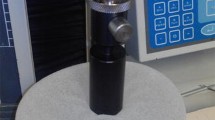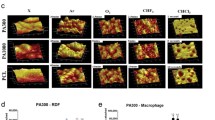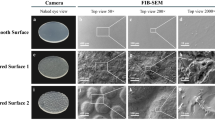Abstract
Recent reports of adverse health effects (e.g., capsular contracture, lymphoma) linked to the absence or presence of texture on soft-tissue implants (e.g., breast implants) suggest surface topography may have pathological impact(s). We propose that surface texture influences the transfer of displacements, experienced by an implant undergoing micromotion, to surrounding interfacial extracellular matrix, which in turn impacts the activity of the resident cells and is based on degree of tissue integration. We hypothesize that transfer of displacements due to micromotion promotes interstitial fluid movement that imposes hydrodynamic stresses (pressures, shear stresses) on cells residing in the interfacial tissues and impacts their activity. To address this, we developed a computer simulation to approximate hydrodynamic stresses in the interstitial environment of saturated poroelastic tissues (model soft-tissue implantation sites) generated from oscillatory implant micromotion as a function of the magnitude of translational displacement, direction of motion, degree of tissue integration, and surface roughness of the implant. Highly integrated implants were predicted to generate the highest fluid shear stresses within model tissues, with oscillatory fluid shear stresses up to 80 dyn/cm2 for a 20-μm displacement. Notably, application of oscillatory 80 dyn/cm2 shear stress to cultured human fibroblasts elicited cell death after 20 h compared to cells maintained under static conditions or exposed to 80 dyn/cm2 steady, unidirectional shear. These results indicate that oscillatory interstitial fluid stresses generated by micromotion of an integrated implant may influence the activity of the surrounding cells and play a role in the body’s fibrotic response to textured soft-tissue implants.








Similar content being viewed by others
Availability of data and material
The principal data generated during the experiments conducted in this study are available within the manuscript and its Supplementary Information. Raw datasets generated during the study are available for research purposes from the corresponding author upon request.
Code availability
The computational model used in the study is available upon request.
References
Akira S, Takeda K (2004) Toll-like receptor signalling. Nat Rev Immunol 4(7):499–511
Aniort J, Chupin L, Cindea N (2018) Mathematical model of calcium exchange during haemodialysis using a citrate containing dialysate. Math Med Biol 35(Suppl_1):87–120
Barone FE, Perry L, Keller T, Maxwell GP (1992) The biomechanical and histopathologic effects of surface texturing with silicone and polyurethane in tissue implantation and expansion. Plast Recon Surg 90(1):77–86
Beavers GS, Joseph DD (1967) Boundary conditions at a naturally permeable wall. J Fluid Mech 30(1):197–207
Bizjak M, Selmi C, Praprotnik S, Bruck O, Perricone C, Ehrenfeld M, Shoenfeld Y (2015) Silicone implants and lymphoma: The role of inflammation. J Autoimmune 65:64–73
Bragdon CR, Jasty M, Greene M, Rubash HE, Harris WH (2004) Biologic fixation of total hip implants. Insights gained from a series of canine studies. J Bone Joint Surg Am 86-a(Suppl 2):105–117
Brody GS, Deapen D, Taylor CR, Pinter-Brown L, House-Lightner SR, Andersen JS, Carlson G, Lechner MG, Epstein AL (2015) Anaplastic large cell lymphoma occurring in women with breast implants: analysis of 173 cases. Plast Recon Surg 135(3):695–705
Brohim RM, Foresman PA, Hildebrandt PK, Rodeheaver GT (1992) Early tissue reaction to textured breast implant surfaces. Ann Plast Surg 28(4):354–362
Burke DW, O’Connor DO, Zalenski EB, Jasty M, Harris WH (1991) Micromotion of cemented and uncemented femoral components. J Bone Joint Surg Br 73(1):33–37
Burkholder TJ (2007) Mechanotransduction in skeletal muscle. Front Biosci 12:174–191
Buser D, Schenk RK, Steinemann S, Fiorellini JP, Fox CH, Stich H (1991) Influence of surface characteristics on bone integration of titanium implants. A histomorphometric study in miniature pigs. J Biomed Mater Res 25(7):889–902
Calobrace MB, Hammond D (2014) Anatomic gel implants: from concept to device. Plast Recon Surg 134(3 Suppl):4S-9S
Chehroudi B, Gould TR, Brunette DM (1990) Titanium-coated micromachined grooves of different dimensions affect epithelial and connective-tissue cells differently in vivo. J Biomed Mater Res 24(9):1203–1219
Chehroudi B, Gould TR, Brunette DM (1991) A light and electron microscopic study of the effects of surface topography on the behavior of cells attached to titanium-coated percutaneous implants. J Biomed Mater Res 25(3):387–405
Chen CS, Mrksich M, Huang S, Whitesides GM, Ingber DE (1998) Micropatterned surfaces for control of cell shape, position, and function. Biotechnol Prog 14(3):356–363
Cimolin F, Discacciati M (2013) Navier-Stokes/Forchheimer models for filtration through porous media. Appl Numer Math 72:205–224
de Jong D, Vasmel WL, de Boer JP, Verhave G, Barbe E, Casparie MK, van Leeuwen FE (2008) Anaplastic large-cell lymphoma in women with breast implants. JAMA 300(17):2030–2035
Ehlers W, Markert B (2001) A linear viscoelastic biphasic model for soft-tissues based on the Theory of Porous Media. J Biomech Eng 123(5):418–424
Ferrier GM, McEvoy A, Evans CE, Andrew JG (2000) The effect of cyclic pressure on human monocyte-derived macrophages in vitro. J Bone Joint Surg Br 82(5):755–759
Garanich JS, Mathura RA, Shi ZD, Tarbell JM (2007) Effects of fluid shear stress on adventitial fibroblast migration: implications for flow-mediated mechanisms of arterialization and intimal hyperplasia. Am J Physiol Heart Circ Physiol 292(6):H3128-3135
Gilletti A, Muthuswamy J (2006) Brain micromotion around implants in the rodent somatosensory cortex. J Neural Eng 3(3):189–195
Giot JP, Paek LS, Nizard N, El-Diwany M, Gaboury LA, Nelea M, Bou-Merhi JS, Harris PG, Danino MA (2015) The double capsules in macro-textured breast implants. Biomaterials 67:65–72
Gu WY, Mao XG, Foster RJ, Weidenbaum M, Mow VC, Rawlins BA (1999) The anisotropic hydraulic permeability of human annulus fibrosis. Spine 23:2449–2455
Hakelius L, Ohlsen L (1992) A clinical comparison of the tendency to capsular contracture between smooth and textured gel-filled silicone mammary implants. Plast Recon Surg 90(2):247–254
Harvestine JN, Orbay H, Chen JY, Sahar DE, Leach JK (2018) Cell-secreted extracellular matrix, independent of cell source, promotes the osteogenic differentiation of human stromal vascular fraction. J Mater Chem B 6(24):4104–4115
Hilborn J, Bjursten LM (2007) A new and evolving paradigm for biocompatibility. J Tissue Eng Regen Med 1(2):110–119
Hoflehner H, Pierer G, Ratschek M, Rehak P, Scharnag E (1994) Subjective and objective assessment of capsular contracture. Eur J Plast Surg 17(1):69–74
Hu H, Jacombs A, Vickery K, Merten SL, Pennington DG, Deva AK (2015) Chronic biofilm infection in breast implants is associated with an increased T-cell lymphocytic infiltrate: implications for breast implant-associated lymphoma. Plast Recon Surg 135(2):319–329
Hung BP, Hutton DL, Grayson WL (2013) Mechanical control of tissue-engineered bone. Stem Cell Res Ther 4(1):10
Hung BP, Gonzalez-Fernandez T, Lin JB, Campbell T, Lee Y, Panitch A, Alsberg E, Leach JK (2020) Multi-peptide presentation and hydrogel mechanics jointly enhance therapeutic duo-potential of entrapped stromal cells. Biomaterials 245:119973
Kilian KA, Bugarija B, Lahn BT, Mrksich M (2010) Geometric cues for directing the differentiation of mesenchymal stem cells. Proc Natl Acad Sci U S A 107(11):4872–4877
Kim JT, Yoo JJ (2016) Implant design in cementless hip arthroplasty. Hip and Pelvis 28(2):65–75
Koutsiaris AG, Tachmitzi SV, Batis N, Kotoula MG, Karabatsas CH, Tsironi E, Chatzoulis DZ (2007) Volume flow and wall shear stress quantification in the human conjunctival capillaries and post-capillary venules in vivo. Biorheology 44(5–6):375–386
Leberfinger AN, Behar BJ, Williams NC, Rakszawski KL, Potochny JD, Mackay DR, Ravnic DJ (2017) Breast implant-associated anaplastic large cell lymphoma: a systematic review. JAMA Surg 152(12):1161–1168
Lin JY, Lo KY, Sun YS (2019) A microfluidics-based wound-healing assay for studying the effects of shear stresses, wound widths, and chemicals on the wound-healing process. Sci Rep 9(1):20016
Loh QL, Chong C (2013) Three-dimensional scaffolds for tissue engineering applications: role of porosity and pore size. Tissue Eng Part B 19:485–502
Loong F, Chan AC, Ho BC, Chau YP, Lee HY, Cheuk W, Yuen WK, Ng WS, Cheung HL, Chan JK (2010) Diffuse large B-cell lymphoma associated with chronic inflammation as an incidental finding and new clinical scenarios. Mod Pathol 23(4):493–501
McEvoy A, Jeyam M, Ferrier G, Evans CE, Andrew JG (2002) Synergistic effect of particles and cyclic pressure on cytokine production in human monocyte/macrophages: proposed role in periprosthetic osteolysis. Bone 30(1):171–177
Meneghin A, Hogaboam CM (2007) Infectious disease, the innate immune response, and fibrosis. J Clin Inves 117(3):530–538
Netti PA, Berk DA, Swartz MA, Grodzinsky AJ, Jain RK (2000) Role of extracellular matrix assembly in interstitial transport in solid tumors. Cancer Res 60:2497–2503
O’Shaughnessy K (2015) Evolution and update on current devices for prosthetic breast reconstruction. Gland Surg 4(2):97–110
Pedersen JA, Boschetti F, Swartz MA (2007) Effects of extracellular fiber architecture on cell membrane shear stress in a 3D fibrous matrix. J Biomech 40(7):1484–1492
Rennie MJ, Wackerhage H, Spangenburg EE, Booth FW (2004) Control of the size of the human muscle mass. Annu Rev Physiol 66:799–828
Rosengren A, Danielsen N, Bjursten LM (1999) Reactive capsule formation around soft-tissue implants is related to cell necrosis. J Biomed Mater Res 46(4):458–464
Rubino C, Mazzarello V, Farace F, D’Andrea F, Montella A, Fenu G, Campus GV (2001) Ultrastructural anatomy of contracted capsules around textured implants in augmented breasts. Ann Plast Surg 46(2):95–102
Saffman PG (1971) On the boundary condition at the interface of a porous medium. Stud Appl Math 50(2):93–101
Seneviratne AN, Cole JE, Goddard ME, Park I, Mohri Z, Sansom S, Udalova I, Krams R, Monaco C (2015) Low shear stress induces M1 macrophage polarization in murine thin-cap atherosclerotic plaques. J Mol Cell Cardiol 89(Pt B):168–172
Smedby KE, Hjalgrim H, Askling J, Chang ET, Gregersen H, Porwit-MacDonald A, Sundstrom C, Akerman M, Melbye M, Glimelius B, Adami HO (2006) Autoimmune and chronic inflammatory disorders and risk of non-Hodgkin lymphoma by subtype. J Natl Cancer Inst 98(1):51–60
Wennerberg A, Ektessabi A, Albrektsson T, Johansson C, Andersson B (1997) A 1-year follow-up of implants of differing surface roughness placed in rabbit bone. Int J Oral Maxillofac Implants 12(4):486–494
Winter W, Klein D, Karl M (2013) Micromotion of dental Implants: basic mechanical considerations. J Med Eng 2013:265412
Wolff JH (1995) Julius Wolff and his “law of bone remodeling.” Orthopade 24(5):378–386
Wynn TA (2008) Cellular and molecular mechanisms of fibrosis. J Pathol 214(2):199–210
Yang L, Kang M, He R, Meng B, Pal A, Chen L, Jheon AH, Ho SP (2019) Microanatomical changes and biomolecular expression at the PDL-entheses during experimental tooth movement. J Periodontal Res 54(3):251–258
Zucca E, Bertoni F, Vannata B, Cavalli F (2014) Emerging role of infectious etiologies in the pathogenesis of marginal zone B-cell lymphomas. Clin Cancer Res 20(20):5207–5216
Acknowledgements
This work was supported by a grant from Office of Women’s Health of the United States Food and Drug Administration (FDA; Department of Health and Human Services) and partially administered by the Oak Ridge Institute for Science and Education through an agreement between the U.S. Department of Energy and FDA. The authors would also like to thank Dr. Sung Yoon, Dr. Min Zhang, and Dr. Cynthia Chang of the Office of Product Evaluation and Quality (OPEQ) in the Center for Devices and Radiological Health (CDRH) at FDA for their feedback during the development and/or execution of this study. This article reflects the views of the author and should not be construed to represent FDA's views or policies.
Funding
This work was supported by a grant from Office of Women’s Health of the United States Food and Drug Administration (FDA; Department of Health and Human Services) and partially administered by the Oak Ridge Institute for Science and Education through an agreement between the U.S. Department of Energy and FDA.
Author information
Authors and Affiliations
Contributions
BPH and HYS wrote the paper. BPH, HYS, and DS formulated the computational model, designed the experimental studies, and analyzed data. BPH conducted the experiments, carried out the statistical analyses, and prepared displays communicating datasets. II and KSP provided substantive scientific contributions to hypothesis development and overall study design as well as technical advice and editorial support.
Corresponding author
Ethics declarations
Conflict of interest
The authors declare that they have no conflict of interest.
Consent for publication
All authors consented to the publication of the data and analyses conducted in the research study described in this manuscript.
Disclaimer
Any mention of commercial products, their sources, or their use in connection with material reported herein is not to be construed as either an actual or implied endorsement of such products by the Department of Health and Human Services. The findings and conclusions in this article have not been formally disseminated by the U.S. Food and Drug Administration and should not be construed to represent any Agency determination or policy.
Additional information
Publisher's Note
Springer Nature remains neutral with regard to jurisdictional claims in published maps and institutional affiliations.
Supplementary Information
Below is the link to the electronic supplementary material.
Rights and permissions
About this article
Cite this article
Hung, B.P., Simon, D.D., Phillips, K.S. et al. Putative mechanobiological impact of surface texture on cell activity around soft-tissue implants undergoing micromotion. Biomech Model Mechanobiol 21, 1117–1131 (2022). https://doi.org/10.1007/s10237-022-01578-1
Received:
Accepted:
Published:
Issue Date:
DOI: https://doi.org/10.1007/s10237-022-01578-1




